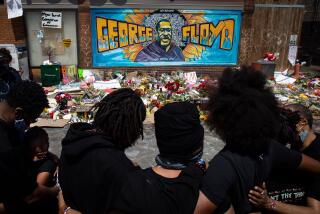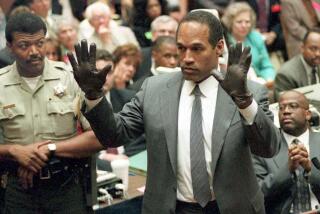How the loss of Columbia eclipsed all other news
- Share via
We have a long-standing daily ritual in our house that my wife calls “morning report.” I’m an early riser, so I make my first pass through the Los Angeles Times and New York Times -- taking notes all the while. Then, after I exercise, make our son’s breakfast and take him to the school bus stop, I return home, get back into bed and -- reading from my notes -- I give my wife the highlights of the day’s news as a kind of heads-up that precedes her reading of the papers (and my return to the papers) over breakfast.
Every once in a while, both newspapers will be so dominated by a single story that I’ll begin “morning report” by saying, “If you’re not interested in [whatever the big story is], you can probably skip the papers today.”
That happened early last week amid the saturation coverage of the disintegration of the space shuttle Columbia and the deaths of the seven astronauts aboard.
There is no question that this was a human tragedy and a devastating blow to our nation’s space program, and we were all stunned and deeply saddened by it. But unlike, say, the terrorist attacks of Sept. 11, the Columbia disaster had no real or even potential effect on the lives of the vast majority of American citizens.
As my 13-year-old son said when I turned on the car radio last Sunday afternoon and the first words he heard were about the Columbia, “Gee, Dad, are they still covering that? What else is there to say now except that the seven people died?”
That was more than 30 hours after Columbia broke apart 40 miles above east Texas. A day later -- Monday -- it was still the lead story on all-news radio on my way to work, when the announcer began his report on a NASA news conference by saying, “So far, there are no new facts....”
If there were no new facts, why was it the lead story?
Radio certainly wasn’t alone in its dedication to “All Columbia, All the Time.”
Time and Newsweek tore up their new issues to provide readers with lengthy cover stories about the disaster -- 17 pages in Time, 18 in Newsweek.
Television once again assumed what Robert S. Lichter, president of the Center for Media and Public Affairs in Washington calls “its role as Greek chorus, professional mourners, a wailing wall of nonstop grief, continuing to express and milk emotion even when there’s no real news to add.”
The Los Angeles Times -- which last Sunday devoted its entire front page and 14 more pages to the story -- published, on Monday, four more Page 1 stories and 10 additional stories on the Columbia, spilling over nine more inside pages. The national edition of the New York Times -- which also gave the story its entire front page (and 10 full inside pages) last Sunday -- did so again Monday (along with eight full inside pages).
Lichter wasn’t the only media analyst who found all this unsettling.
“We are headed for a war that, whether you like it or not, is likely to be enormously consequential for this country,” says Todd Gitlin, a professor of sociology and journalism at Columbia University in New York, “and it seems highly peculiar to derail that coverage, even if just for a couple of days ... in favor of wall-to-wall coverage of an event that, while a tragedy, is not the national equivalent of a terrorist attack or the assassination of a political leader.”
To be fair, it’s worth noting that the New York Times and Los Angeles Times each published an Iraq story on Page 1 Monday, with the New York Times story at the top of the page under a headline that paired it with the shuttle story: “NASA Finds Clues in Shuttle Disaster; No Delay on Iraq Plans, Bush Aides Say.”
Iraq goes missing
But many other major papers -- the Philadelphia Inquirer, Chicago Tribune and USA Today among them -- had no Iraq coverage on Page 1 Monday. Gitlin and Orville Schell, dean of the Graduate School of Journalism at UC Berkeley, were critical of the overwhelming attention given to the shuttle disaster, and both attributed the excess coverage in part to the nation’s new sense of vulnerability.
The shuttle failure was “like an attack on our national sense of prowess,” and the resultant saturation coverage “speaks to some awful fear that we’re about to plunge into darkness,” Gitlin said.
Schell said that with the scars of the Sept. 11 attacks still visible on the nation’s psyche, and with war likely and the economy weak, he thinks the media were reacting to “the symbolism of [the Columbia failure], which really rattles us in terms of ... our wavering self-confidence and uncertainty about the future.
“I was horrified” by the deaths of the astronauts, Schell said, “but it was a horror made for television. Sad as it is, if you ask, ‘What’s the significance of this story?’ and ‘What does it mean to us?’ it was, what, seven people?”
Coverage of the shuttle disaster “raises questions about the equivalence of human tragedy,” Schell said. “Chechnya, Rwanda, Timor and many other stories that are of much greater and more lasting significance -- wars, famines and epidemics that last years, maybe a lifetime ... and affect thousands, tens of thousands of people -- don’t receive anywhere near this much attention.”
The space shuttle explosion is far from the first tragic news event of limited real impact on the average American to receive saturation coverage in the media. It happened with the deaths of Princess Di and John F. Kennedy Jr. and with the murder trial of O.J. Simpson -- and it will happen again.
It’s not surprising when all-news radio and cable TV fill the airwaves with one story, hour after hour. They’re 24-hour news operations, and on most days there’s not enough real news to fill that gaping hole. Lichter thinks their constant coverage helps drive newspaper coverage. But newspapers have a different mission, and their readers have different needs. Do readers really want 25 separate stories on the Columbia, as USA Today provided on Monday, along with 45 photos, drawings and other graphic elements (and that doesn’t include the four Columbia stories and three pictures in the paper’s Life section, or the story and four pictures that dominated the first page of its Sports section)?
“The nation has a powerful connection to the space program,” said Brian Gallagher, executive editor of USA Today, “and this was a major event that calls into question the centerpiece of our manned space program.
“It also raises questions about whether corners were cut as budgets were cut, and it’s a human tragedy, and there’s a mystery of why it happened,” Gallagher said. “It was worth the space we gave it to give readers all they want.”
The shuttle disaster is a heartbreaking story, and the shocking drama of the event, with body parts and shuttle pieces falling from the sky, certainly merited media attention. As the investigation into its causes unfolds, there are bound to be stories of substantial importance to the families of the dead astronauts and to the future of the U.S. space program.
Even before then -- after Secretary of State Colin Powell’s address to the United Nations on Wednesday -- Iraq had returned to the headlines.
But in the first days after the disaster, I thought the news media were once again guilty of confusing the spectacular with the significant.
*
David Shaw can be reached at david.shaw@latimes.com.
More to Read
Sign up for Essential California
The most important California stories and recommendations in your inbox every morning.
You may occasionally receive promotional content from the Los Angeles Times.













